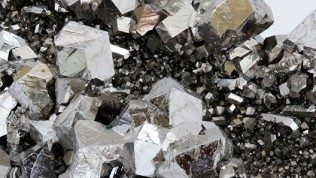
By José Tadeu Arantes | Agência FAPESP – For over 65 years, niobium boride (NbB) has been considered a classic example of a superconducting material. This assumption, recorded in manuals on the physics of condensed matter and articles in scientific journals, has now been contested in a study conducted by researchers at the University of São Paulo (USP) in Brazil and at San Diego State University in the United States.
In an article published in Physical Review Materials, the researchers show that the superconductivity detected hitherto was not due to NbB. The superconducting properties were associated with filaments of almost pure niobium that “meandered around” the grains of NbB in the samples studied.
The principal investigator for the study was Renato de Figueiredo Jardim, Full Professor in the University of São Paulo’s Physics Institute (IF-USP) and Director of its Lorena School of Engineering (EEL-USP). The study was conducted under the aegis of the Center for Research and Development of Functional Materials (CDMF), one of 17 Research, Innovation and Dissemination Centers (RIDCs) funded by FAPESP.
“We know the element niobium (Nb) on its own is superconductive when chilled to very low temperatures in the range of 9.2 kelvins,” Jardim told Agência FAPESP. “Now, we’ve discovered that this is not the case for NbB. Samples of NbB contain a large volumetric fraction of NbB but also a small amount of almost pure Nb. Two distinct crystalline phases coexist in the materials studied. This minority phase, comprising approximately 98% niobium and 2% boron, is what behaves as a superconductor.”
In the electron microscope images reproduced in the article, the white filaments correspond to the minority phase consisting of approximately 98% niobium and 2% boron. The notation used to characterize this composition is Nb0.98B0.02. The gray areas, corresponding to the larger volumetric fraction, are NbB.
The authors note that even if it occurs in a small volumetric fraction, the minority phase (Nb0.98B0.02) is superconductive and forms a three-dimensional mesh through which the electrical current can transit from one extremity of the material to the other.
This feature is highly likely to have misled the researchers who previously investigated NbB, so that they found the material to be superconductive at temperatures below approximately 9 kelvins.
“We clearly identified this lattice structure by scanning electron microscopy,” Jardim explained. “The visual evidence was qualitative proof of the property, as it were, but this point alone was insufficient to confirm our hypothesis. We had to go further in search of quantitative proof. We did so by applying a thermodynamic model to the data taken from the materials studied, and in this way, we obtained the proof we sought.”
From the macroscopic standpoint, superconductivity is a property of certain materials that, when cooled below a given temperature, conduct electricity without any energy loss – i.e., with zero electrical resistance.
“Alongside this macroscopic property, there’s another property, which is also macroscopic, called ‘perfect diamagnetism’,” Jardim said.
Thanks to this second property, the superconductor’s interior magnetic field is completely excluded when the material is placed in an external magnetic field.
“Diamagnetism can be viewed as the generation of a current on the surface of the material that results in a magnetic field of the same magnitude as the external magnetic field that’s being applied but acting in the opposite direction. It’s as if the material expels from its interior the magnetic field in which it is immersed,” Jardim explained.
The study was also supported by FAPESP via scholarships for the projects “Search for novel superconducting materials” and “Superconductivity in (Nb1-xZrx)B solid solutions”.
MRI and dewars
Diamagnetism is present in all materials. However, it is often so weak that its manifestation is masked by other, more robust magnetic responses, such as ferromagnetism, in which the material is attracted by an external magnetic field, and paramagnetism, in which the material’s atomic magnetic dipoles align parallel to the external magnetic field.
When the diamagnetic response is sufficiently strong, as in a superconductor, the repulsion due to the magnetic field can cause the material to levitate. This phenomenon has recently become famous.
The technological applications of superconductivity are fairly well known today. The main application is in coils made with superconducting wire. When such a coil is cooled and thermally insulated, an applied electrical current flows through it indefinitely, generating magnetic fields without energy dissipation. This kind of device is used in magnetic resonance imaging (MRI) equipment, which has become commonplace.
“The technology has advanced a great deal in recent years,” Jardim said. “A special type of vacuum flask called a dewar is used for cryogenic storage with an inner temperature at the level of liquid helium, which is 4.2 kelvins [approximately minus 270 °C]. These dewars are commercially available and can be used to refrigerate superconducting coils.”
According to Jardim, no technological applications are currently foreseen for NbB, “but a ‘cousin’ of NbB, magnesium diboride (MgB2), has aroused strong interest since the start of the last decade. Our research may contribute to its technological application.”
The article “Absence of superconductivity in NbB” by F. Abud, L. E. Correa, I. R. Souza Filho, A. J. S. Machado, M. S. Torikachvili and R. F. Jardim can be read by subscribers at journals.aps.org/prmaterials/abstract/10.1103/PhysRevMaterials.1.044803.
Link to original article: http://agencia.fapesp.br/research-dispels-misconception-of-superconductivity-in-niobium-compound/
